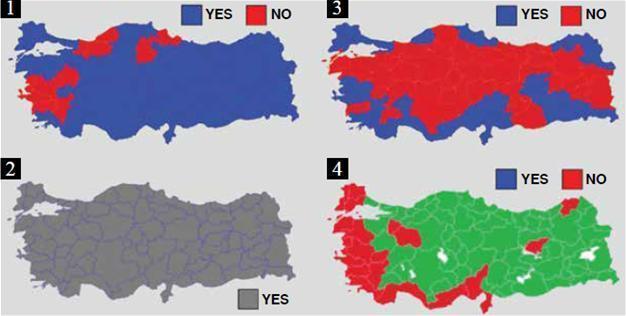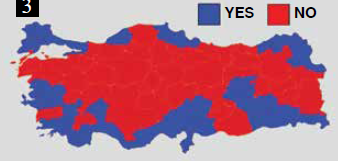ANALYSIS: Which map will appear on April 16?
ERTUĞRUL ÖZKÖK
 Here are four maps of Turkey that I will present for your perusal. These maps are colored according to the “no” and “yes” vote results of the constitutional referendums held in Turkey up until now.
Here are four maps of Turkey that I will present for your perusal. These maps are colored according to the “no” and “yes” vote results of the constitutional referendums held in Turkey up until now. 
First map: 1961 Constitution
The constitution drafted after the military coup of May 27, 1960, went to a vote on July 8, 1961. The outcome was 61.7 percent “yes” and 38.3 percent “no.”
The map of Turkey according to the “yes” and “no” votes in 1961 looked like this: The Aegean city of İzmir and a couple of more provinces surrounding it, Adapazarı – east of Istanbul – and a small region in the Black Sea said “no” to the constitution prepared by the military regime.
The rest of Turkey and those regions that predominantly vote for the Justice and Development Party (AKP) today voted “yes” to the military regime’s constitution at that time. This constitution remained in effect for 21 years with some amendments.

Second map: 1982 Constitution
The constitution drafted by the Sept. 12, 1980, military regime was put before the populace on Nov. 7, 1982. The outcome was 91.4 percent “yes” and 8.6 percent “no.” This map of Turkey was a single color. All of Turkey said “yes” to the military regime constitution. This constitution has stayed in effect with various amendments up until today; in other words, for a period of 35 years.
The AKP came to power according to this constitution; Tayyip Erdoğan became the prime minister when this constitution was in force.

The third map: 1987 constitutional change
The 1982 Constitution imposed a political ban on politicians who were active before the Sept. 12 coup. The amendment to lift this political ban was submitted to the public on July 12, 1987. The outcome was 50.16 percent in favor of lifting the ban and 49.84 percent against. The map of “yes” and “no” votes in Turkey showed that the Aegean coast, the Mediterranean, Thrace, Istanbul, the southeast and certain Black Sea provinces voted for the political bans to be lifted. Those regions that voted for the continuation of the political ban are today those regions that mostly vote for the AKP.

Fourth map: 2010 constitutional change
The constitutional amendment that introduced massive changes to the justice system in Turkey was voted on on Sept. 12, 2010. The outcome was 57.9 percent in favor of the judicial changes and 42.11 percent against.
In this referendum, the two-color map of Turkey demonstrated that Thrace, the Aegean region, the Mediterranean region and a couple of provinces in Anatolia voted against the changes in the judicial system.
The remaining regions of Turkey, including the southeast, voted for this constitutional change that speeded up the structuring of what is now called the Fethullahist Terrorist Organization (FETÖ).
Only seven years have passed since this referendum and we have all observed what this constitutional amendment has turned the justice system into.
As a matter of fact, there was another constitutional referendum in 1988, but because it was on an absurd matter as to when to hold local elections, I did not include that one here.
Which outcome will bring what?
If the outcome of the upcoming vote is 51 percent affirmative, this, in my opinion, will not introduce a sustainable regime in Turkey. I am predicting that this regime will be changed with a civilian consensus constitution that will be approved by at least 70 percent of the people.
If the outcome is 51 percent “no,” this will also not mean that we do not need a new charter and that the current system is adequate to rule the country.
As a result, Turkey absolutely and undeniable has to write a truly civilian constitution.
Sooner or later, all of us will need to draft a constitution in which we will all feel confident facing justice, the bureaucracy, police and military, in which we will entrust our future not to individuals but institutions.
The percentage on April 16
The historic fact that these four maps tells us is that, except for the Sept. 12 referendum, Thrace, the Aegean coasts and the Mediterranean region of Turkey have opposed military coup constitutions, continuations of political bans and the politicization of the justice system.
What kind of a map are we going to see on the evening of April 16? I don’t know. Opinion polls report that they are head to head. Thus, a 51 percent approval or a 51 percent disapproval will not be surprising to anyone.
I can’t predict the outcome, but I can imagine what the map will look like. This map will most probably look like the “third map” above. In other words, Thrace, the Aegean, the Mediterranean and Southeast Anatolia will say “no” in a clear and definite fashion while the rest of Turkey will say “yes.”
It is reported that Istanbul is neck and neck.
Those regions that approved the lifting of political bans in 1987 will this time say “no” to a strengthened presidential system. The part of Turkey that was in favor of the continuation of political bans at that time will say “yes” to a strengthened presidential system.
















